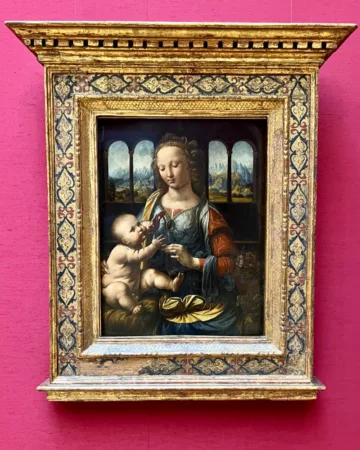The top paintings in the Alte Pinakothek in Munich include a remarkable self-portrait by a 28-year-old Albrecht Dürer, 72 works by Peter Paul Rubens, and the only Leonardo Da Vinci in a museum in Germany.
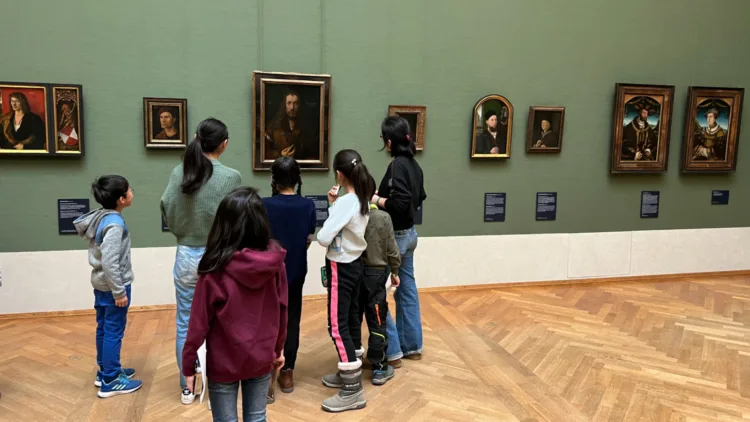
The Alte Pinakothek in Munich is an excellent gallery to gain a rounded education on the development of European paintings from the Middle Ages to 1780 in a single museum. It competes with the Gemäldegalerie in Berlin and the Germanisches National Museum in Nuremberg to be the most impressive art museum of Old Masters in Germany. The Early German collection is considered the most comprehensive in the world while no fewer than 72 paintings form the largest Rubens collection in the world. The Dutch Primitives as well as Golden Age works are also very extensive. Paintings in the vast Italian galleries range from Giotto to Canaletto and include the only Da Vinci in Germany. The French and Spanish collections of paintings from the 16th to 18th centuries are smaller but with all top artists represented. As a bonus, until 2029, a selection of 19th-century paintings are also on display. Book a private tour to see the highlights of the Alte Pinakothek in two hours.
Top Early German Paintings in the Alte Pinakothek in Munich
The collection of Early Geman paintings, or German Primitives, in the Alte Pinakothek is considered the most comprehensive in the world. Most of the Gothic and Renaissance paintings have a religious theme but two of the most praised works are secular portrayals:
Albrecht Dürer: Self-Portrait
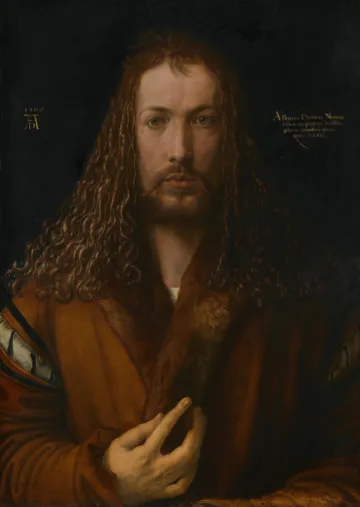
The best-known painting in the Alte Pinakothek, and possibly in all of Germany, is Self-Portrait with Fur-Trimmed Robe (Selbstbildnis im Pelzrock), 1500, by Albrecht Dürer. It shows the 28-year-old Nuremberg Renaissance painter facing straightforward — a print, ten times enlarged, in the Albrecht-Dürer-Haus Museum in Nürnberg shows the work still in perfect focus without any pixelation.
The immediate frontality and detail in the painting were highly unusual for a secular portrayal of the period and even more so for a self-portrait. It is sometimes also referred to as Albrecht Dürer as Jesus Christ.
The painting bears Dürer’s familiar AD trademark as well as an inscription in Latin translated as “I, Albrecht Dürer of Nuremberg portrayed myself in appropriate colors aged twenty-eight years”.
At least twelve self-portrait images by Dürere survive, of which only two were paintings that are now in the Louvre in Paris and Prado in Madrid.
Other important Dürer works in the museum include the Paumgartner-Altar: Lukas Paumgartner as St Eusatchius, around 1500, Lamentation (Glimsche Beweinung), around 1500, and Suicide of Lucretia, 1518. Dürer gifted his last large works, two panels of The Four Apostles (1526) measuring 215 cm x 76 cm (85 in x 30 in), to the city of Nuremberg but the Wittelsbach Elector Maximillian I moved both to Munich in 1627 — only copies are on display in Nuremberg.
Albrecht Altdorfer: The Battle of Alexander at Issus



Albrecht Altdorfer’s masterpiece The Battle of Alexander at Issus (Alexanderschlacht), 1529, commissioned by Bavarian Duke Wilhelm IV, shows Alexander the Great’s final victory over King Darius III of Persia in 333 BC. This Renaissance world landscape shows the famous battle in the foreground while the background stretches from the Mediterranean Sea to the Nile in Egypt. (In 1814, the painting was recovered from Napoleon Bonaparte’s private bathroom.) A further work by Altendorf in the Pinakothek is Susanna Bathing (Susanna im Bade), 1516.
Cranach and Other German Primitives in the Alte Pinakothek

Any average German art museum has a Lucas Cranach but the Alte Pinakothek has nearly a hundred to choose from. It has the usual portraits of Martin Luther and Philip Melanchton, as well as an Adam and Eve. Of the various crucifixion scenes, Lamentation Beneath the Cross (Klage unter dem Kreuz), 1503, is the most noteworthy. Also note his Anna Selbdritt (St Anne, Virgin, and Child), 1516. The Suicide of Lucretia, 1524/30, also shows the German vision of a female nude in the period similar to many Venus paintings by Cranach in other museums.
Further Early German paintings in the Alte Pinakothek in Munich include:
- Stefan Lochner: (Adoration of the Christ Child by the Virgin (Anbetung des Kindes), 1445, Last Judgement Altarpiece (Flügel des Weltgerichtsaltares), 1440/50.
- Martin Schongauer: The Holy Family (Die Heilige Familie), 1475/80.
- Hans Baldung Grien: Margrave Christoph of Baden (Markgraf Christoph von Baden), 1515.
- Hans Holbein the Elder: St. Sebastian Altar; Central panel: Martyrdom of St. Sebastian (Sebastiansaltar: Martyrium des hl. Sebastian), 1516.
- Matthias Grünewald: Saints Erasmus und Maurice, 1520/24, Mocking of Christ (Verspottung Christi), c. 1503/05.
- Michael Pacher: Altarpiece of the Church Fathers (Kirchenväteraltar), c. 1480.
Top Early Netherlandish Paintings in the Alte Pinakothek in Munich
The early Netherlandish paintings (Dutch Primitives) are among the most comprehensive and most impressive collections in the world:
Rogier van der Weyden: Saint Columba Altarpiece

The Saint Columba Altarpiece, or Adoration of the Kings (Der Columba-Altar, or Dreikönigsaltar), c. 1450–1455, is a late work by the early Netherlandish painter Rogier van der Weyden (c. 1400-1464). This triptych was originally commissioned for the St Columba church in Cologne, where it remained until the early 19th century.
The triptych illustrates scenes from the early life of Christ: on the left wing, the annunciation, the adoration of the magi at the nativity as the main scene, and the presentation in the temple on the right. The clothes and backgrounds show exquisite details: Goethe observed that there is no place on the panel not worth exploring further with a magnifying glass.
The triptych is full of symbolism: Mary wears royal blue throughout. Her prayer chair has a carving of the Original Sin, which was balanced out by the birth (and death) of Christ, while lilies are the symbol of her virginity. The small crucifix in the stable is a premonition of the fate awaiting the Child (although it is often used as a “spoiler alert” in memes). The interior of the temple is Romanesque as a symbol of the Old Testament while the exterior (seen in the main scene) is modern Gothic (contemporary at the time of painting) to show the new beginning of the New Testament.
The quality of the Columba Altarpiece is so good that it was long attributed to Jan van Eyck, about the only significant early Netherlandish artist unrepresented in the Pinakothek collection but for a 1439 copy of his Vera Icon.
More Dutch Primitives in the Alte Pinakothek

A few further top early Netherlandish paintings on display include:
- Dieric Bouts: Ecce Agnus Dei, 1462/64.
- Hans Memling: The Seven Joys of the Virgin (Die Sieben Freuden Mariens), 1480, and several panels from altars including St George with the Donor, c. 1480/90, and St Anne, the Virgin, and Child (Anna Selbdritt), c. 1480.
The real artists of several further works from this period are disputed and are more likely by the followers (or copiers) of:
- Hieronymus Bosch: Fragment from the Last Judgment (Fragment eines Jüngsten Gerichts), c. 1515
- Dieric Bouts: Pearl of Brabant Altarpiece (Perle von Brabant), c. 1465.
- Rogier van der Weyden: St Luke Drawing the Virgin (Der hl. Lukas zeichnet die Madonna), c. 1484.
Italian Highlights in the Alte Pinakothek in München

The Alte Pinakothek München has a good selection of Italian paintings including works by most of the famous artists from the 13th to 18th century. The oldest paintings in the museum are by Giotto and Fra Angelico but the Renaissance and Baroque works are particularly popular.
Leonardo da Vinci: Madonna of the Carnation
Leonardo da Vinci’s Madonna of the Carnation, also known as the Madonna with Vase, Madonna with Child, or Virgin with Flower (Madonna del Garofano in Italian or Madonna mit der Nelke in German), c. 1478-80, is one of the earliest known paintings by Da Vinci and was probably painted during his apprenticeship to Andrea del Verrocchio. It is an oil on panel painting currently measuring 62 cm × 47.5 cm (24 in × 18.7 in).
In this painting, there is no eye contact between the Madonna and Child. The child, in an unnatural position, looks towards heaven, while Mary looks at the red carnation — a symbol of blood and the Passion. The almost transparent flower vase is apparently the only vase in a known Da Vinci painting.
Madonna of the Carnation is the only Leonardo da Vinci painting in a museum in Germany. It currently hangs in Gallery IV on the upper floor. On an average day, it is fascinating to see how many visitors stroll by without paying it any attention.
Raphael: Canigiani Holy Family
Of the three paintings by Raphael in the Alte Pinakothek, the most famous is the Canigiani Holy Family (Raffael: Die hl. Familie aus dem Hause Canigiani), c. 1505. In this painting, Raphael used vivid colors to paint Joseph and Mary with the infant Christ together with his cousin John (the Baptist) and Elisabeth. In the background is a typical European city. The small angels at the top of the work were overpainted from the late 18th century until 1983.
Two smaller Raphael Madonna and Child paintings hang on either side of the Holy Family:
- The Tempi Madonna, c. 1508, is a particularly tender portrayal of a mother and baby — King Ludwig I negotiated its purchase over two decades with the Duchess Tempi.
- The Madonna della tenda (Madonna of the Curtain / Madonna mit dem Vorhang), 1513-14, is less tender and has a young John the Baptist in the scene.
More Italian Highlights in the Alte Pinakothek in Munich



- Giotto: The Last Supper (Letztes Abendmahl), c. 1303/06.
- Fra Angelico: Entombment of Christ (Grablegung Christi), c. 1438, Scenes from Saints Cosma and Damian from the predella of the San Marco Altar in Florence.
- Sandro Botticelli: Lamentation over the Dead Christ (Beweinung Christi), c. 1490/95.
- Fra Filippo Lippi: The Annunciation (Verkündigung Mariae), c. 1443/45, and Madonna and Child (Maria mit Kind), c. 1460/65.
- Antonello da Messina: Annunciata (Annunciation / Maria der Verkündigung), c. 1473.
- Titian: Vanity (Die Eitelkeit der Welt), c. 1515, Charles V (Kaiser Karls V. im Lehnstuhl), 1548, and many copies and followers.
- Tintoretto: Christ in the House of Mary and Martha (Chrisus bei Maria and Martha), c. 1580, Vulcan Surprised Venus and Mars (Vulkan überrascht Venus und Mars), c. 1555, and Gonzaga Cycle, c. 1578.
- Paolo Veronese: Amor with two dogs (Amor mit zwei Hunden), 1575, and many more, as well as numerous copies.
- Guido Reni: The Assumption of the Virgin (Die Himmelfahrt Mariae), c. 1638.
- Tiepolo: The Adoration of the Kings (Die Anbetung der Könige), 1753.
- Francesco Guardi: Regatta on the Canale della Guidecca, ca. 1784.
- Canaletto: Piazetta Bacino di San Marco, c. 1736, and other Venice scenes.
Top Flemish Paintings in München
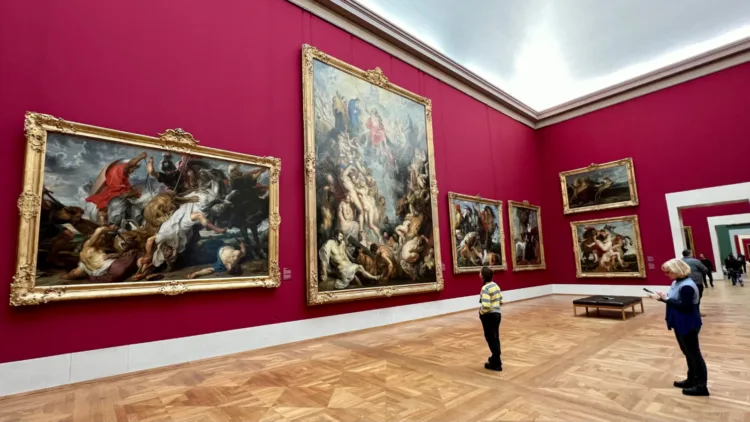
The Flemish paintings are in the central galleries of the museum. Many are of monumental size and include many by Peter Paul Rubens and Anthony van Dyck.
Peter Paul Rubens: The Large Last Judgment
The Alte Pinakothek in Munich has with 72 paintings the largest permanent collection of Peter Paul Rubens works in the world. A large number is on display — most are physically big, full of people (of the fuller figure), coming to live in colorful scenes of big moment events. Picking the best or even just a favorite is hard, which normally pushes one of his last judgments to the front.
The “large” in The Large Last Judgment (Das Große Jüngste Gericht), 1617, by Rubens refers to its size. This monumental work is enormous: it measures 608,5 x 463,5 cm (240 x 183 inches). It is the largest painting in the Alte Pinakothek in Munich and still hangs where Leo van Klenze placed it in 1836 — in Gallery VII in the center of the museum opposite the cut-out to Room 12, so visitors may appreciate it in its full length from a greater distance. In Room 12, Rubens’ The Small Last Judgement (Das Kleine Jüngste Gericht), c. 1621, measures only 185 x 120 cm.
The large painting was commissioned by Wolfgang Wilhelm von Pfalz-Neuburg for the high altar of the court church but locals found the nudity too racy and it ended up in the Wittelsbach art collection in Düsseldorf, which eventually moved to Munich when this branch succeeded to the Bavarian throne.
Other notable Peter Paul Rubens paintings include the self-portrait Rubens with Isabella Brant in the Honeysuckle Bower (Rubens und Isabella Brant in der Geißblattlaube), c. 1609/10; The Fall of the Damned (Der Höllensturz der Verdammten), c. 1621; Hunt Scene with Hippopotamus and Crocodile (Jagd auf Nilpferde und Krokodil), c. 1616; Drunken Silenes (Der trunkene Silen), c. 1618/25; Massacre of the Innocents in Bethlehem (Der bethlehemitische Kindermord), c. 1638; Susanna and the Elders (Susanna und die beiden Alten), 1636/38; and Cupid Carving a Bow (Amor schnitzt den Bogen), 1614.
Pieter Bruegel d. Ä: The Land of Cockaigne
The Alte Pinakothek has several small paintings by the extended Bruegel artist family. The most interesting is Pieter Bruegel the Elder’s The Land of Cockaigne (Das Schlaraffenland), 1566. It is also referred to as The Land of Milk and Honey. The comical illustration shows two of the seven deadly sins: gluttony and sloth and how all classes could succumb to these weaknesses.
Several works are by Jan Brueghel the Elder and typically crowded with many people, including Harbour Scene with Christ Preaching (Seehafen mit der Predigt Christi), c. 1598, and Big Fishmarket (Großer Fischmarkt), 1603.
Other Flemish Paintings in the Alte Pinakothek in Munich
- Anthony van Dyck: Many top works including St Sebastian (Martyrium des hl. Sebastian), 1622/23, Self-Portrait as a Young Man (Selbstbildnis), c. 1620, Susanna and the Elders (Susanna und die beiden Alten), c. 1622, and many further large portraits with exquisite details in the clothing.
- Jan Mabuse: Danae, 1527.
- Jacob Jordaens: Allegory of Fertility (Allegorie der Fruchtbarkeit), c. 1617, and Satyr with Peasants (Der Satyr beim Bauern), c. 1620.
- Adriaen Brouwer: A dozen small-format peasant scenes, c. 1620-40.
Best Dutch Golden Age Paintings

The Alte Pinakothek has an extensive collection of Dutch 17th-century paintings as some Wittelsbach rulers collected these works extensively. Although none of these paintings are particularly famous, works are present by most notable painters of the period, except Vermeer.
Rembrandt van Rijn: The Descent from the Cross

The Alte Pinakothek owns several paintings by Rembrandt van Rijn, although these are certainly not his most famous or best works. The six paintings of the Passion-Cycle are the best-known of the Rembrandts and of these The Descent from the Cross (Kreuzabname Christi), c. 1633, is the most significant work. Rembrandt used his own likeness for the man in pale blue here as well as in The Raising of the Cross (Die Kreuzaufrichtung). Other scenes include The Nativity, The Entombment, The Resurrection, and The Ascension.
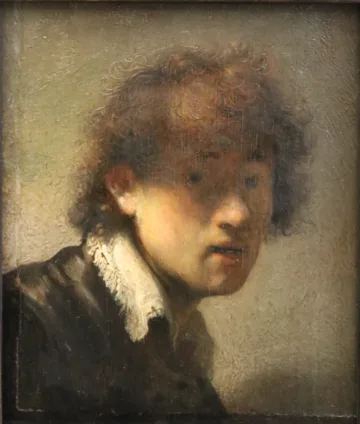

Further works by Rembrandt in the museum include a Self-Portrait as a Young Man (Jugendliches Selbstbildnis), 1629; Portrait of a Man in Oriental Costume (Brustbild eines Mannes in orientalischem Kostüm), 1633, The Holy Family (Die Heilige Familie), 1633/35, and The Risen Christ (Die auferstandene Christus), 1661. The Sacrifice of Isaac is now generally attributed to his workshop.
Other Dutch Golden Age Paintings
The Alte Pinakothek has a large collection of Dutch old master paintings with Vermeer the only significant Golden Age painter without a work in the collection. Some further interesting works include:
- Frans Hals: Portrait of Willem Croes, 1660/62, and his only known full-body portrait — Bildnis des Willem van Heythuysen, c. 1625 (not currently on display).
- Ferdinand Bol: Governors of the Amsterdam Wine Merchant’s Guild (Die Vorsteher der Amsterdamer Weinhändlergilde), 1659.
- Carel Fabritius: Self-Portrait (Selbstbildnis), 1650.
- Gerard ter Borch: The Flea-Catcher or Boy with His Dog (Ein Knabe floht seinen Hund, c. 1655
- Melchior d’Hondecoeter: several large paintings with birds and bird parks, c. 1671.
- Several landscapes by Jacob van Ruisdael and Salomon van Ruysdael.
Best of Spain and France in the Alte Pinakothek in Munich
The Alte Pinakothek has a relatively small collection of French and Spanish paintings from the period 1500 to 1780.
French Paintings:
The most celebrated French painting in the museum is Francois Boucher’s Madame de Pompadour, 1756. Madame de Pompadour, the mistress of French King Louis XV, commissioned this work herself so it obviously shows her as a great beauty. However, even more impressive is her dress with voluptuous floral decorations.
Other top French works include:
- Nicolas Poussin: Midas and Bacchus, c. 1624.
- Claude Lorrain: Sea Port at Sunrice (Ein Seehafen bei aufgehender Sonne), 1674, and The Expulsion of Hagar (Verstoßung der Hagar), 1668.
Spanish Paintings:
The Spanish collection (1500-1780) is the smallest of the museum’s collections but still includes works by most of the major artists from the period.
In the past, the most popular work for copying by studying artists in the Alte Pinakothek was Bartolomé Esteban Murillo: Boys Eating Grapes and Melon (Trauben- und Melonenesser).
- El Greco: The Disrobing of Christ (Die Entkleidung Christi), 1580-95.
- Velázquez: Young Spanish Gentleman (Junger spanischer Edelmann), c. 1631.
- Jusepe de Ribera: Saint Bartholomew (Hl. Bartholomäus), 1633.
- Francisco de Zurbarán: St. Francis in Ecstasy (Der hl. Franziskus in Ekstase), c. 1660.
19th-Century Paintings in the Alte Pinakothek in Munich
The extensive 19th-century paintings collection of the Bavarian State Painting Collections is usually on display in the nearby Neue Pinakothek. However, while the Neue Pinakothek is being reconfigured, many of the most popular works — including German Romantics, French Impressionists, Secession, and The Blue Rider — are on temporary display in other venues including the Alte Pinakothek. The Neue Pinakothek will reopen only in 2029, so visitors are likely to enjoy this bonus for several years.
Some of the 19th-century paintings currently on display in the Neue Pinakothek include several by Caspar Friedrich David, Johan Christian Dahl, Karl Friedrich Schinkel, William Turner, Gustav Klimt, Max Lieberman, Vincent van Gogh, many French Impressionists, and even a few sculptures.
→ See also Visiting the Alte Pinakothek in Munich for more details on the museum, opening hours, and admission tickets.
More on Top Art Museums in München
- Where to See What — a brief description of Munich’s top art museums and galleries.
- Alte Pinakothek — top Old Master paintings (and some 19th-century paintings while the Neue Pinakothek is under renovation.)
- Glyptohek — one of the world’s best Greek and Roman sculpture collections from antiquity.
- Lenbachhaus — the largest The Blue Rider collection in the world but also modern art exhibitions.
- Save with the Munich Card and City Pass on transportation and sightseeing — most museums are covered.
- Visit the royal castles of King Ludwig II near Munich to see the 19th-century historicist interiors of Schloss Neuschwanstein, Linderhof, and Herrenchiemsee Palace.

